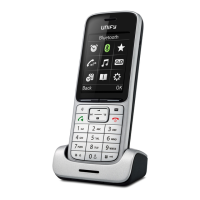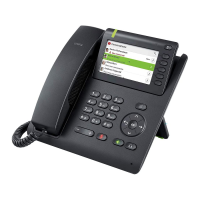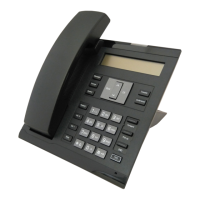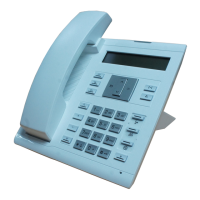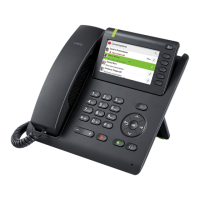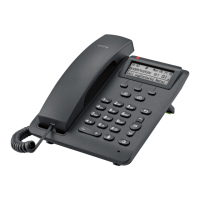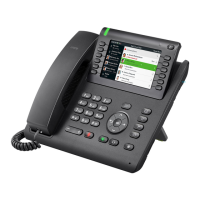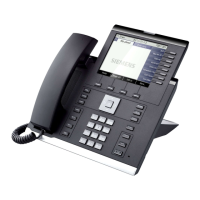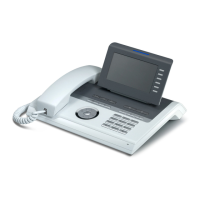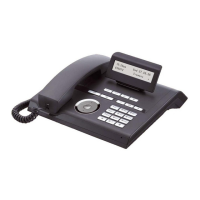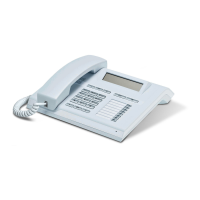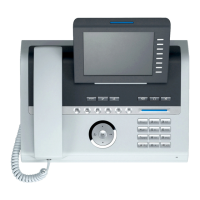



Do you have a question about the Unify OpenScape Business and is the answer not in the manual?
Explains the meaning of symbols used in the manual for better comprehension and safety.
Provides access to online resources, license details, and installation guidelines.
Introduces the document, its purpose, and how it should be used by readers.
Explains the icons, display conventions, and general illustration methods used in the guide.
Identifies and describes the physical controls and display elements of the telephone.
Details the physical connection ports and key technical specifications of the OpenScape CP600.
Explains how to use the phone's network port to connect a PC, saving a network port.
Describes the optional OpenScape Key Module 600 and its attachment to the phone.
Explains the functionality of softkeys, audio control keys, and volume adjustments.
Details the operations performed using the navigator keys for list navigation and actions.
Covers numeric and text input methods using the phone's dialpad.
Explains how to read and understand the call history and conversation list.
How to access and navigate the main menu of the phone from any screen.
Explains the meaning of various icons displayed in the notification area and status bar.
How to set your current availability status and choose duration options.
Explains the FPK screen feature for quick access to favorite functions.
Illustrates how softkeys and navigation keys are used for actions like searching and dialing.
How to initiate calls using the dialpad or select items via navigation keys.
Steps for sending short text messages to other participants via the phone.
Guides on how to move through the phone's menus and activate applications.
Explains the icons used in the conversations list to indicate call status and type.
How to open conversation details and initiate calls using softkeys or navigation.
Steps to edit contact details such as last name, first name, and work number.
Further details on editing various contact fields like mobile, company, and email addresses.
How to save updated contact data and how it appears on subsequent calls.
Procedure for creating a new contact from the conversation list options.
How to search for contacts using alphanumeric or numeric input via the search field.
Using comma and hash characters to refine search queries for better results.
How to filter the conversation list to display specific call types like missed or dialed calls.
How to view detailed call histories and access past interaction logs.
Steps to delete unwanted entries from the call history or contact list.
Explains how incoming calls are signaled and displayed, and how to accept or ignore them.
How to manage multiple incoming calls, including ignored waiting calls.
Details functions like consultation, transfer, and sending messages available during an active call.
Explains the icons that indicate the status of calls and the connection type.
Guide to programming keys in the Favorites menu with functions or phone numbers.
Steps to access key programming, change features, and navigate through function lists.
How to configure a 'Shift key' function and save changes to key programming.
Explains the meaning of LED indicators for different states of function keys.
How to access the main settings menu and navigate through user-specific configuration options.
Details on configuring local settings like Ringer, Audio, and other user preferences.
How to set parameters for room acoustics and headset socket configurations.
Guide to adjusting display brightness, key module contrast, and volume levels via menus.
Steps to enable the FPK screen through the settings menu for quick access.
How to adjust idle menu mode, brightness, and key module contrast.
Instructions for switching between the standard idle menu and the FPK menu.
How to adjust display tilt and brightness for optimal viewing.
Procedure to change the language for user guidance displayed on the phone.
Setting inactivity timers for backlight dimming and screen switch-off to save energy.
Adjusting the contrast of key labels on the OpenScape Key Module 600 for ambient lighting.
Adjusting the brightness of key labels on the OpenScape Key Module 600.
Steps to activate the idle screen feature, which acts as a screensaver.
How to transfer and set custom images for the idle screen via the web interface.
Configuring the inactivity period before the idle screen activates automatically.
Configuring the time intervals for changing idle screen images.
How to set volumes for loudspeaker, handset, headset, and call loudspeaker.
Instructions for deactivating the ringer, activating alert tones, and muting active ringers.
Adjusting phone settings to improve speakerphone audio quality based on room acoustics.
How to select and configure preferred ringtones for internal and external calls.
Setting up the phone to use wired or cordless headsets, or a conference device via the headset port.
How to set your presence status (e.g., Office, Meeting) and specify the duration.
How to switch off away status or forward calls by setting presence to Office.
How to activate or deactivate call waiting and its associated signal tones.
Steps to assign speed-dial numbers to keys for quick dialing.
How to switch the night answer mode on or off for call forwarding.
Detailed steps for assigning functions or numbers to programmable keys using various methods.
Summary of available functions and explanations of LED displays on function keys.
How to save call numbers and complex functions to keys for easier access.
Steps to configure dialing keys on the second level of the Key Module for advanced dialing.
How to assign phone numbers and labels using contact data from previous calls.
How to choose the correct phone number from a contact's multiple entries.
How to edit the number and label associated with a dialing key.
Steps to delete programmed functions or key assignments from the Key Module.
How to program and remove local features, such as the door opener, onto function keys.
Steps to remove a local feature that has been programmed onto a key.
How to receive and answer incoming calls using the handset, loudspeaker, or headset.
How to pick up calls intended for colleagues using direct station selection or line keys.
How to manage calls where you are spoken to directly via the phone's loudspeaker.
Enabling or disabling the handsfree answerback feature for better audio interaction.
How to temporarily switch the microphone on or off during a call.
Methods for making calls by lifting the handset or keeping it on-hook.
How to make calls using a connected headset, with instructions for internal and external numbers.
How to select contacts from the conversations list and redial previous calls.
Using central speed dial numbers and configuring speed-dial keys for quick dialing.
How to create and send short text messages to individuals or groups.
Procedures for deleting sent messages and viewing received messages, including notifications.
How to record or leave a message/response text when you are unavailable.
How to assign specific numbers for outgoing calls and configure rollover options.
How to configure call forwarding to different destinations via the call forwarding menu.
Methods to activate and deactivate call forwarding using dedicated keys or the idle menu.
How to set up call forwarding for when calls are not answered within a specified time.
Steps to activate or deactivate call forwarding specifically to the office.
How to request a callback when a party is busy and how to accept an incoming callback.
Procedures for checking and deleting saved callback requests.
How to switch between handset and speakerphone modes during an active call.
Managing incoming calls while on another call, including accepting, rejecting, or holding.
How to transfer an active call to another person or colleague.
Steps to park active calls and retrieve them from any phone, including managing parking positions.
How to place a call on hold and manage recalls after hanging up.
How to initiate a conference call and add multiple participants.
How to disconnect participants from a conference and end the conference call.
How to send DTMF signals to control answering machines or other systems.
Guide to importing contact lists from CSV files using the Web-Based Management interface.
Explains the steps involved in pairing Bluetooth devices for wireless communication.
Step-by-step instructions for connecting a Bluetooth headset to the phone.
How to test the connection of a paired headset and make test calls.
How to receive contact data in vCard format and save it to the phone's contact list.
Methods for sending contact information as vCards to other Bluetooth devices.
Steps to pair and connect Bluetooth conference phones for audio conferencing.
How to test the call handling and participant management of a Bluetooth conference phone.
How to manage incoming calls from mobile devices connected via Bluetooth (HFAG).
Making outgoing calls using a Bluetooth mobile device and troubleshooting dialing issues.
How HFAG call status is displayed in the phone's main menu screen.
How HFAG calls are shown and distinguished in the conversations list.
How to configure settings like 'Hide mobiles data' for anonymous operation of Bluetooth calls.
Explains how keyboard navigation keys and input methods function with the phone.
Describes the different pairing modes supported for Bluetooth keyboards.
Steps to pair a Bluetooth remote button and configure its actions on the phone.
Explains the 'Trigger on reconnect' functionality for remote buttons when disconnected.
How to turn the Bluetooth function on and off on the phone.
Functions for adding, deleting, connecting, and renaming Bluetooth devices.
Procedures for establishing and terminating connections with Bluetooth devices.
How to use Proximity Monitoring for automatic connection and disconnection of Bluetooth devices.
Adjusting proximity settings and managing audio for Bluetooth devices.
How to remove Bluetooth devices from the list or change their names.
Steps to add Bluetooth devices to a blacklist to prevent connection attempts.
How to set up or deactivate the Eddystone Beacon for proximity services.
How to set up a server connection for beacons, including URI and interval configuration.
Explains different types of telephone lines (Primary, Secondary, Private, Shared, Direct) and trunk distinctions.
How line/trunk keys function and the meaning of their LED status indicators.
How to hold calls on line keys and alternate between multiple active calls.
How to use the MULAP conference release function to join or manage conference calls.
Explains the meaning of LED indicators on DSS keys for team member status.
How to directly call team members, transfer calls, or pick up calls using DSS keys.
How to activate call forwarding for a specific line, impacting all associated line keys.
Steps to deactivate call forwarding for lines and understanding LED notifications.
How to enable or disable direct call transfer to a manager or secretary.
How to turn group call and hunt group functionality on or off.
How to manage membership in multiple groups and interpret group status indicators.
How to set up group ringing and manage group members for incoming calls.
How to log into and out of the UCD system as an agent for call assignment.
Requesting post-processing time and managing night service for UCD.
How to view the number of calls currently waiting in the call distribution queue.
How to activate idle mode and do not disturb (DND) functions for privacy.
How to block your phone number or name from appearing on the recipient's display.
How to lock the phone to prevent unauthorized access and unlock it with a password.
Procedures for locking and unlocking other phones against unauthorized use.
How to assign and change a personal lock code for phone security features.
Steps to change the user password for security and access to phone settings.
How to disable the password prompt for user settings and phone lock functions.
How to activate the phone lock to prevent unauthorized use of functions and calls.
How to display connection costs for ongoing or past calls on the phone.
How to display and print fee-based call information from other phones using a programmed key.
How to assign external calls to specific projects using account codes for charge assessment.
How to set up timed reminders for appointments and manage saved entries.
How the phone rings and displays an appointment reminder at the set time.
How to allow others to temporarily use your phone for their calls, mimicking your own settings.
Explains the two mobility variants for connecting to different phones and their data handling.
Steps for logging onto a mobile connection designated as a 'guest phone' for seamless call management.
How to transfer call connections between guest phones and log off the current guest phone connection.
Procedure for resetting phone services and functions, including a list of deleted features.
How to activate/deactivate functions for other phones using codes and the associated services menu.
How to use Direct Inward System Access (DISA) for external connections and accessing system functions.
How to control connected computers or information systems via the phone.
How to respond to search requests initiated by paging equipment or other systems.
How to assign a key to activate/deactivate camera video streams for monitoring.
How to activate and view video streams from configured cameras on the phone.
How to program a key for door opening and use it to grant access to visitors.
How to speak with visitors via the door phone and operate the door opener.
How to watch a video stream from the entrance camera before answering a door phone call.
How to access the video stream after answering a door phone call and talk to the visitor.
How to log out from hunt groups or group calls within a networked environment.
How to activate or deactivate call forwarding for your phone from other network phones.
How to set phones on other systems as night destinations for call forwarding.
How to save, display, or delete phones associated with a ringing group for simultaneous ringing.
How to activate the door release function from other OpenScape Business systems.
How to set and adjust volumes for loudspeaker, ringer, handset, and headset.
How to select and configure ringtones for different call types like internal or external.
How to choose between HiPath and Local ringtone modes to determine ringer generation.
How to enable or disable blocking for outgoing calls and delete characters from entries.
Steps to enter server address, user name, password, and folder for Exchange account access.
How to log into the UC server and configure UC journal and user credentials.
How to activate UC Voicemail and access voicemail notifications within the conversation list.
How to play, mark, delete, or stop voice messages during playback.
How to view the current status information for a potential SD card in the phone.
How to access and browse network details like IP address, URL, and activity.
Procedure to reset all personal settings, screensaver images, and ringer files to factory defaults.
How to access the phone's settings and configuration options via a web browser.
How to access and navigate user-specific settings through the web interface or phone menus.
Details on configuring phone settings like display, inactivity, and slideshow image transfers.
Explains common error messages, their causes, and appropriate responses.
How to open the user menu on the phone and navigate its various configuration options.
Overview of user configuration for outgoing calls, block dialing, and other phone settings.
Details functions, their availability via dialog/service menu, and corresponding codes.
Continuation of function codes covering messages, conferences, dialing, and mobile login.
Details function codes for call pickup, forwarding, silent mode, and phone locking.
Explains the meaning of various icons displayed in the phone's notification area for status updates.
Explains the meaning of symbols used in the manual for better comprehension and safety.
Provides access to online resources, license details, and installation guidelines.
Introduces the document, its purpose, and how it should be used by readers.
Explains the icons, display conventions, and general illustration methods used in the guide.
Identifies and describes the physical controls and display elements of the telephone.
Details the physical connection ports and key technical specifications of the OpenScape CP600.
Explains how to use the phone's network port to connect a PC, saving a network port.
Describes the optional OpenScape Key Module 600 and its attachment to the phone.
Explains the functionality of softkeys, audio control keys, and volume adjustments.
Details the operations performed using the navigator keys for list navigation and actions.
Covers numeric and text input methods using the phone's dialpad.
Explains how to read and understand the call history and conversation list.
How to access and navigate the main menu of the phone from any screen.
Explains the meaning of various icons displayed in the notification area and status bar.
How to set your current availability status and choose duration options.
Explains the FPK screen feature for quick access to favorite functions.
Illustrates how softkeys and navigation keys are used for actions like searching and dialing.
How to initiate calls using the dialpad or select items via navigation keys.
Steps for sending short text messages to other participants via the phone.
Guides on how to move through the phone's menus and activate applications.
Explains the icons used in the conversations list to indicate call status and type.
How to open conversation details and initiate calls using softkeys or navigation.
Steps to edit contact details such as last name, first name, and work number.
Further details on editing various contact fields like mobile, company, and email addresses.
How to save updated contact data and how it appears on subsequent calls.
Procedure for creating a new contact from the conversation list options.
How to search for contacts using alphanumeric or numeric input via the search field.
Using comma and hash characters to refine search queries for better results.
How to filter the conversation list to display specific call types like missed or dialed calls.
How to view detailed call histories and access past interaction logs.
Steps to delete unwanted entries from the call history or contact list.
Explains how incoming calls are signaled and displayed, and how to accept or ignore them.
How to manage multiple incoming calls, including ignored waiting calls.
Details functions like consultation, transfer, and sending messages available during an active call.
Explains the icons that indicate the status of calls and the connection type.
Guide to programming keys in the Favorites menu with functions or phone numbers.
Steps to access key programming, change features, and navigate through function lists.
How to configure a 'Shift key' function and save changes to key programming.
Explains the meaning of LED indicators for different states of function keys.
How to access the main settings menu and navigate through user-specific configuration options.
Details on configuring local settings like Ringer, Audio, and other user preferences.
How to set parameters for room acoustics and headset socket configurations.
Guide to adjusting display brightness, key module contrast, and volume levels via menus.
Steps to enable the FPK screen through the settings menu for quick access.
How to adjust idle menu mode, brightness, and key module contrast.
Instructions for switching between the standard idle menu and the FPK menu.
How to adjust display tilt and brightness for optimal viewing.
Procedure to change the language for user guidance displayed on the phone.
Setting inactivity timers for backlight dimming and screen switch-off to save energy.
Adjusting the contrast of key labels on the OpenScape Key Module 600 for ambient lighting.
Adjusting the brightness of key labels on the OpenScape Key Module 600.
Steps to activate the idle screen feature, which acts as a screensaver.
How to transfer and set custom images for the idle screen via the web interface.
Configuring the inactivity period before the idle screen activates automatically.
Configuring the time intervals for changing idle screen images.
How to set volumes for loudspeaker, handset, headset, and call loudspeaker.
Instructions for deactivating the ringer, activating alert tones, and muting active ringers.
Adjusting phone settings to improve speakerphone audio quality based on room acoustics.
How to select and configure preferred ringtones for internal and external calls.
Setting up the phone to use wired or cordless headsets, or a conference device via the headset port.
How to set your presence status (e.g., Office, Meeting) and specify the duration.
How to switch off away status or forward calls by setting presence to Office.
How to activate or deactivate call waiting and its associated signal tones.
Steps to assign speed-dial numbers to keys for quick dialing.
How to switch the night answer mode on or off for call forwarding.
Detailed steps for assigning functions or numbers to programmable keys using various methods.
Summary of available functions and explanations of LED displays on function keys.
How to save call numbers and complex functions to keys for easier access.
Steps to configure dialing keys on the second level of the Key Module for advanced dialing.
How to assign phone numbers and labels using contact data from previous calls.
How to choose the correct phone number from a contact's multiple entries.
How to edit the number and label associated with a dialing key.
Steps to delete programmed functions or key assignments from the Key Module.
How to program and remove local features, such as the door opener, onto function keys.
Steps to remove a local feature that has been programmed onto a key.
How to receive and answer incoming calls using the handset, loudspeaker, or headset.
How to pick up calls intended for colleagues using direct station selection or line keys.
How to manage calls where you are spoken to directly via the phone's loudspeaker.
Enabling or disabling the handsfree answerback feature for better audio interaction.
How to temporarily switch the microphone on or off during a call.
Methods for making calls by lifting the handset or keeping it on-hook.
How to make calls using a connected headset, with instructions for internal and external numbers.
How to select contacts from the conversations list and redial previous calls.
Using central speed dial numbers and configuring speed-dial keys for quick dialing.
How to create and send short text messages to individuals or groups.
Procedures for deleting sent messages and viewing received messages, including notifications.
How to record or leave a message/response text when you are unavailable.
How to assign specific numbers for outgoing calls and configure rollover options.
How to configure call forwarding to different destinations via the call forwarding menu.
Methods to activate and deactivate call forwarding using dedicated keys or the idle menu.
How to set up call forwarding for when calls are not answered within a specified time.
Steps to activate or deactivate call forwarding specifically to the office.
How to request a callback when a party is busy and how to accept an incoming callback.
Procedures for checking and deleting saved callback requests.
How to switch between handset and speakerphone modes during an active call.
Managing incoming calls while on another call, including accepting, rejecting, or holding.
How to transfer an active call to another person or colleague.
Steps to park active calls and retrieve them from any phone, including managing parking positions.
How to place a call on hold and manage recalls after hanging up.
How to initiate a conference call and add multiple participants.
How to disconnect participants from a conference and end the conference call.
How to send DTMF signals to control answering machines or other systems.
Guide to importing contact lists from CSV files using the Web-Based Management interface.
Explains the steps involved in pairing Bluetooth devices for wireless communication.
Step-by-step instructions for connecting a Bluetooth headset to the phone.
How to test the connection of a paired headset and make test calls.
How to receive contact data in vCard format and save it to the phone's contact list.
Methods for sending contact information as vCards to other Bluetooth devices.
Steps to pair and connect Bluetooth conference phones for audio conferencing.
How to test the call handling and participant management of a Bluetooth conference phone.
How to manage incoming calls from mobile devices connected via Bluetooth (HFAG).
Making outgoing calls using a Bluetooth mobile device and troubleshooting dialing issues.
How HFAG call status is displayed in the phone's main menu screen.
How HFAG calls are shown and distinguished in the conversations list.
How to configure settings like 'Hide mobiles data' for anonymous operation of Bluetooth calls.
Explains how keyboard navigation keys and input methods function with the phone.
Describes the different pairing modes supported for Bluetooth keyboards.
Steps to pair a Bluetooth remote button and configure its actions on the phone.
Explains the 'Trigger on reconnect' functionality for remote buttons when disconnected.
How to turn the Bluetooth function on and off on the phone.
Functions for adding, deleting, connecting, and renaming Bluetooth devices.
Procedures for establishing and terminating connections with Bluetooth devices.
How to use Proximity Monitoring for automatic connection and disconnection of Bluetooth devices.
Adjusting proximity settings and managing audio for Bluetooth devices.
How to remove Bluetooth devices from the list or change their names.
Steps to add Bluetooth devices to a blacklist to prevent connection attempts.
How to set up or deactivate the Eddystone Beacon for proximity services.
How to set up a server connection for beacons, including URI and interval configuration.
Explains different types of telephone lines (Primary, Secondary, Private, Shared, Direct) and trunk distinctions.
How line/trunk keys function and the meaning of their LED status indicators.
How to hold calls on line keys and alternate between multiple active calls.
How to use the MULAP conference release function to join or manage conference calls.
Explains the meaning of LED indicators on DSS keys for team member status.
How to directly call team members, transfer calls, or pick up calls using DSS keys.
How to activate call forwarding for a specific line, impacting all associated line keys.
Steps to deactivate call forwarding for lines and understanding LED notifications.
How to enable or disable direct call transfer to a manager or secretary.
How to turn group call and hunt group functionality on or off.
How to manage membership in multiple groups and interpret group status indicators.
How to set up group ringing and manage group members for incoming calls.
How to log into and out of the UCD system as an agent for call assignment.
Requesting post-processing time and managing night service for UCD.
How to view the number of calls currently waiting in the call distribution queue.
How to activate idle mode and do not disturb (DND) functions for privacy.
How to block your phone number or name from appearing on the recipient's display.
How to lock the phone to prevent unauthorized access and unlock it with a password.
Procedures for locking and unlocking other phones against unauthorized use.
How to assign and change a personal lock code for phone security features.
Steps to change the user password for security and access to phone settings.
How to disable the password prompt for user settings and phone lock functions.
How to activate the phone lock to prevent unauthorized use of functions and calls.
How to display connection costs for ongoing or past calls on the phone.
How to display and print fee-based call information from other phones using a programmed key.
How to assign external calls to specific projects using account codes for charge assessment.
How to set up timed reminders for appointments and manage saved entries.
How the phone rings and displays an appointment reminder at the set time.
How to allow others to temporarily use your phone for their calls, mimicking your own settings.
Explains the two mobility variants for connecting to different phones and their data handling.
Steps for logging onto a mobile connection designated as a 'guest phone' for seamless call management.
How to transfer call connections between guest phones and log off the current guest phone connection.
Procedure for resetting phone services and functions, including a list of deleted features.
How to activate/deactivate functions for other phones using codes and the associated services menu.
How to use Direct Inward System Access (DISA) for external connections and accessing system functions.
How to control connected computers or information systems via the phone.
How to respond to search requests initiated by paging equipment or other systems.
How to assign a key to activate/deactivate camera video streams for monitoring.
How to activate and view video streams from configured cameras on the phone.
How to program a key for door opening and use it to grant access to visitors.
How to speak with visitors via the door phone and operate the door opener.
How to watch a video stream from the entrance camera before answering a door phone call.
How to access the video stream after answering a door phone call and talk to the visitor.
How to log out from hunt groups or group calls within a networked environment.
How to activate or deactivate call forwarding for your phone from other network phones.
How to set phones on other systems as night destinations for call forwarding.
How to save, display, or delete phones associated with a ringing group for simultaneous ringing.
How to activate the door release function from other OpenScape Business systems.
How to set and adjust volumes for loudspeaker, ringer, handset, and headset.
How to select and configure ringtones for different call types like internal or external.
How to choose between HiPath and Local ringtone modes to determine ringer generation.
How to enable or disable blocking for outgoing calls and delete characters from entries.
Steps to enter server address, user name, password, and folder for Exchange account access.
How to log into the UC server and configure UC journal and user credentials.
How to activate UC Voicemail and access voicemail notifications within the conversation list.
How to play, mark, delete, or stop voice messages during playback.
How to view the current status information for a potential SD card in the phone.
How to access and browse network details like IP address, URL, and activity.
Procedure to reset all personal settings, screensaver images, and ringer files to factory defaults.
How to access the phone's settings and configuration options via a web browser.
How to access and navigate user-specific settings through the web interface or phone menus.
Details on configuring phone settings like display, inactivity, and slideshow image transfers.
Explains common error messages, their causes, and appropriate responses.
How to open the user menu on the phone and navigate its various configuration options.
Overview of user configuration for outgoing calls, block dialing, and other phone settings.
Details functions, their availability via dialog/service menu, and corresponding codes.
Continuation of function codes covering messages, conferences, dialing, and mobile login.
Details function codes for call pickup, forwarding, silent mode, and phone locking.
Explains the meaning of various icons displayed in the phone's notification area for status updates.
| Category | IP Phone |
|---|---|
| Manufacturer | Unify |
| Product Name | OpenScape Business |
| Networking | Ethernet |
| Supported Protocols | SIP |
| Power Supply | PoE (Power over Ethernet) or external power supply (depending on model) |
| Headset Port | Yes, 3.5mm jack |
